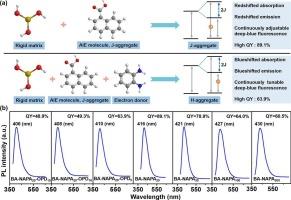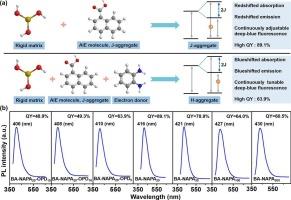A molecular-based aggregation engineering strategy for high-efficiency deep-blue phosphors
IF 4.3
2区 工程技术
Q2 ENGINEERING, CHEMICAL
引用次数: 0
Abstract
Deep-blue emissive phosphors play a crucial role in fabricating phosphor-converted light-emitting diodes (pc-LEDs). Although solid-state luminescence technology has made significant progress, challenges still remain in achieving high-efficiency emission in the deep-blue spectral region. In this work, through spatial rigidity engineering to suppress the non-radiative transition process, we developed a highly efficient deep-blue emission system. In this system, boric acid (BA) was used as the matrix and 1-naphthoic acid (NAPA), an aggregation-induced emission (AIE) molecule, was employed as the fluorophore. By the incorporation of electron donor o-phenylenediamine (OPD) into the system promoted a transition of NAPA from J-aggregation to H-aggregation, effectively broadening the tunable range of fluorescence emission spectra. It’s found that the synergistic effects of hydrogen bonding interactions and the AIE mechanism enabled continuously tunable luminescent materials within the deep-blue range (406 nm to 430 nm), with a maximum quantum yield (QY) of 89.1 %. Exciting the deep-blue phosphor with a 365 nm chip resulted in bright blue light with CIE chromaticity coordinates of (0.155, 0.071) under a drive current of 60 mA. This study introduces a simple and universal method to fabricate solid-state phosphors with emission-tunable properties via molecule-based aggregation engineering, effectively overcoming the limitations of spectral rigidity and poor adaptability to diverse application scenarios in current deep-blue materials.


高效深蓝色荧光粉的分子聚合工程策略
深蓝发光荧光粉在制造磷光转换发光二极管(pc- led)中起着至关重要的作用。虽然固态发光技术已经取得了很大的进步,但在深蓝光谱区域实现高效发射仍然存在挑战。在这项工作中,我们通过空间刚性工程来抑制非辐射转变过程,我们开发了一个高效的深蓝发射系统。该体系以硼酸(BA)为基质,以聚集诱导发射(AIE)分子1-萘酸(NAPA)为荧光团。通过电子给体邻苯二胺(OPD)的加入,促进了NAPA从j聚集向h聚集的转变,有效地拓宽了荧光发射光谱的可调范围。研究发现,在氢键相互作用和AIE机制的协同作用下,可以在深蓝范围(406 nm ~ 430 nm)内实现连续可调发光材料,最大量子产率(QY)为89.1% %。用365 nm芯片激发深蓝色荧光粉,在60 mA的驱动电流下产生CIE色度坐标为(0.155,0.071)的明亮蓝光。本研究引入了一种简单通用的基于分子聚集工程的方法来制备具有发射可调特性的固态荧光粉,有效克服了目前深蓝材料光谱刚性和对多种应用场景适应性差的局限性。
本文章由计算机程序翻译,如有差异,请以英文原文为准。
求助全文
约1分钟内获得全文
求助全文
来源期刊

Chemical Engineering Science
工程技术-工程:化工
CiteScore
7.50
自引率
8.50%
发文量
1025
审稿时长
50 days
期刊介绍:
Chemical engineering enables the transformation of natural resources and energy into useful products for society. It draws on and applies natural sciences, mathematics and economics, and has developed fundamental engineering science that underpins the discipline.
Chemical Engineering Science (CES) has been publishing papers on the fundamentals of chemical engineering since 1951. CES is the platform where the most significant advances in the discipline have ever since been published. Chemical Engineering Science has accompanied and sustained chemical engineering through its development into the vibrant and broad scientific discipline it is today.
 求助内容:
求助内容: 应助结果提醒方式:
应助结果提醒方式:


